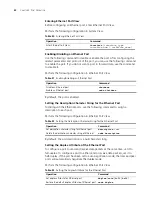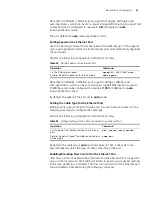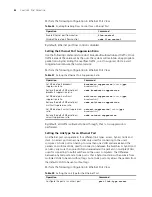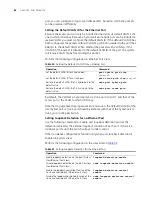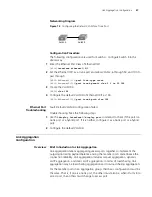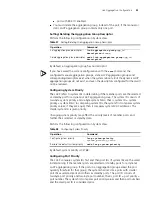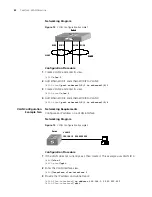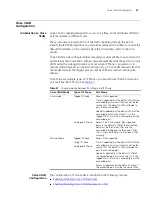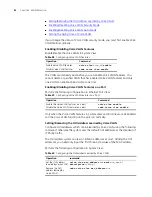
50
C
HAPTER
2: P
ORT
O
PERATION
systems as well as under manual control through direct manipulation of the state
variables of Link Aggregation (for example, keys) by a network manager.
Dynamic LACP aggregation can be established even for a single port, as is called
single port aggregation. LACP is enabled at dynamic aggregation ports. Only the
ports with the same speed, duplex mode and basic configuration and connected
to the same device can be aggregated dynamically.
Because only a defined number of ports can be supported in an aggregation
group, if the ports in an aggregation group exceed the port quantity threshold for
that group, the system shall set some ports with smaller system IDs (system priority
+ system MAC address) and port IDs (port pr port number) as selected ports
and others as standby ports. If not, all member ports are selected ports. Both
selected and standby ports can transceive LACP protocol, but standby ports
cannot forward user service packets. Among the selected ports of an aggregation
group, the one with minimum port number serves as the master port for that
group and the others are sub-ports.
In comparing system IDs, the system first compares system priority values; if they
are equal, then it compares system MAC addresses. The smaller system ID is given
priority. Comparing port IDs follows the same process: the system first compares
port priority values and then port numbers and the smaller port ID is given priority.
If system ID changes from non-priority to priority, then the selected or standby
state is determined by the port priority of the system. You can decide whether the
port is selected or standby by setting system priority and port priority.
Load Sharing
In terms of load balancing, link aggregation may be load balancing aggregation
and non-load balancing aggregation. In general, the system only provides limited
load balancing aggregation resources, so the system needs to rationally allocate
these resources among manual aggregation groups, static LACP aggregation
groups, dynamic LACP aggregation groups, and the aggregation groups including
special ports which require hardware aggregation resources. The system will
always allocate hardware aggregation resources to the aggregation groups with
higher priority levels. When the load sharing aggregation resources are used up for
existing aggregation groups, newly-created aggregation groups will be non-load
sharing ones. The priority levels (in descending order) for allocating load sharing
aggregation resources are as follows:
■
Aggregation groups including special ports which require hardware
aggregation resources
■
Manual and static LACP aggregation groups
■
Aggregation groups that probably reach the maximum rate after the resources
are allocated to them
■
Aggregation groups with the minimum master port numbers if they reach the
equal rate with other groups after the resources are allocated to them
When aggregation groups of higher priority levels appear, the aggregation groups
of lower priority levels release their hardware resources. For single-port
aggregation groups, if they can transceive packets normally without occupying
hardware resources, they shall not occupy the resources.
Содержание 400 Family
Страница 12: ......
Страница 16: ...14 ABOUT THIS GUIDE ...
Страница 58: ...56 CHAPTER 2 PORT OPERATION ...
Страница 68: ...66 CHAPTER 3 VLAN OPERATION ...
Страница 98: ...96 CHAPTER 5 NETWORK PROTOCOL OPERATION ...
Страница 124: ...122 CHAPTER 6 IP ROUTING PROTOCOL OPERATION ...
Страница 156: ...154 CHAPTER 8 ACL CONFIGURATION ...
Страница 218: ...216 CHAPTER 11 802 1X CONFIGURATION ...
Страница 298: ...296 CHAPTER 13 PASSWORD CONTROL CONFIGURATION OPERATIONS ...
Страница 336: ...334 APPENDIX B RADIUS SERVER AND RADIUS CLIENT SETUP ...





